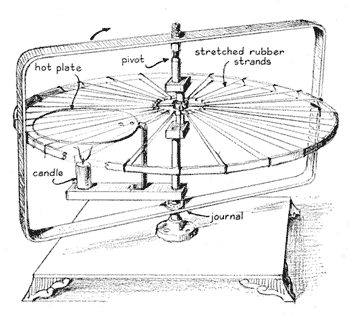| g e n u i n e i d e a s | ||||||
 |
 |
 |
 |
 |
 |
 |
| home | art and science |
writings | biography | food | inventions | search |
| c))motion solar wheel toys | ||
|
Solar Wheels are desktop toys which rotate slowly in the sun, meant for gentle amusement rather than active play. Many solar toys rely on gas expansion or liquid evaporation to power the device. But there are simpler techniques, if you have the right material- such as the c))motion plastic film. In this case, the solar toy is decorated with a number of black plastic strips along the perimeter- like cars on a Ferris wheel. These strips are bilayers, laminated from two plastics with different expansion coefficients. When heated by the sun or even a table lamp, the difference in thermal expansion causes the strip to "bow" (note the strips near the lamp are more curved than those shaded by the wheel). Since they bow away from the center of rotation, the center of mass is moves toward the lamp, and the wheel - now unbalanced- rotates in response. A large solar wheel (about a foot in diameter) generates enough power to be coupled to a cart and propel its wheels, though not very fast or over a bumpy surface. There is more information on these plastic strips, named c))motion, at talusfurniture. While Genuine Ideas initially created the films to address important environmental and energy problems, they are also finding application in toys. For example, these solar Ferris wheel prototypes called "anemone" and "tripus":
Additional c))motion solar wheel designs, such as the diamond-shaped "pinwheel" and the two-bladed "scoop", are available at talus furniture, while there is more about solar rockers here on genuineideas.
|
||
Contact Greg Blonder by email here - Modified Genuine Ideas, LLC. |

